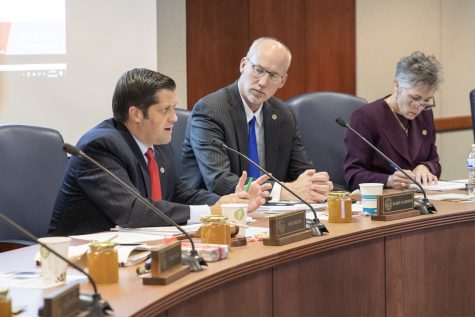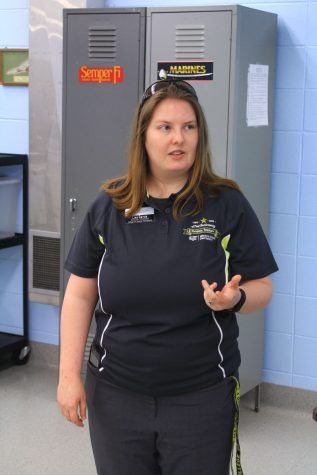Shockers on ice: a task of safety
Freezing weather brings thoughts of holiday cheer with friends by a warm fire.
It also brings thoughts of frozen cars, cold walks between classes and the ever-looming thought of slipping on ice-covered sidewalks between classes.
In order to keep members of the Wichita State community safe, the job of tackling the accumulated snow and ice has to be taken care of.
“Everybody has a designated area,” said Arlan Klocke, landscape technician at the WSU Physical Plant. “I have campus divided up and everybody knows what buildings they need to do. It is pretty well organized.”
Although the department of landscape and ground maintenance work year-round, their work can be primarily viewed in the green, colorful flowerbeds and trimmed grass throughout campus.
As the weather turns in the fall, a few extra duties become primary, such as sowing flower seeds for the spring, leaf cleanup and concrete repairs.
“If we didn’t pick up leaves in the fall, they would be three feet deep, covering other shrubs and walkways,” said Kari Ossman, landscape technician.
However, the weather does not stop changing in the fall — snow and ice is inevtiable.
A typical day
On a typical snowy day, campus preparations begin long before students and faculty begin to arrive.
“The turf area depends on if we have snow or ice — and, if we do have snow or ice, we try to be here two hours early,” Klocke said.
As landscape department employees arrive at work, preparations are made for the next eight hours of their shifts.
Bags of ice melt are opened and dumped into spreaders. A rock salt and sand mixture is loaded into the payload area of two large dump trucks. Large mowers — normally used to cut grass during the warmer months — are converted into blading machines. Mowing decks are removed, replaced with a large scraping blade and a cab is placed over the seat to keep the operator out of the elements.
“We get out right away,” Klocke said. “It takes a little while to get our scooters cleaned off but then we designate areas to go take care of.”
After those preparations, the landscaping team sets out to clear campus, following a pre-determined path that has been laid out based on target and priority areas. Looking like a spider web of cleared area, the team of workers clear the majority of well-traveled areas before students and faculty arrive on campus.
“If it is a bad storm, we are in three hours early,” Ossman said.
Logistics
Although clearing well-traveled areas with a large team of people can be done efficiently, facing constant precipitation over the 330-acre campus is an ongoing battle.
“If it is a really cold day, we could move [a lot of ice melt] with shovels in the morning but then have to re-treat the frozen water later on during the day when it melts,” Ossman said.
In order to treat for snow and ice, large amounts of resources are needed, including seven bladers and equipment operators for each of those.
The department also has the potential of going through a large amount of ice melt during one push to clear pathways and driveways.
“We can go through a pallet in the morning really easy and a pallet contains 50 bags,” Klocke said.
Although it is a priority to clear every area that Shockers may travel in order to get around campus, some areas are harder than others due to building constraints and simple thermodynamics.
The Heskett Center, for example, has a roof that is shaped like a block, which collects snow, Klocke said.
As a result, the landscape department has to block off certain walkways around the Heskett in order to maintain student safety.
“The blocked roof collects snow, so we have to block off sidewalks,” Klocke said. “Snow will fall and hurt someone over there.”
How Shockers can help
With the team out working to clear areas of known dangers, there is a potential for new problem areas to pop up. As a result of that, the landscape team is always listening for new areas to take care of.
With frequent events on campus, part of the job of the landscaping team is to pay attention to areas where large groups of people are located.
“We do pay attention to what is happening on campus,” Ossman said. “Whatever is the most danger to campus individuals has the highest priority.”
By working with the community, Ossman said that the department’s job can be done more effectively, keeping the WSU community safe from slips, falls and other weather-related accidents.
“Call 978-3444. We will put it up on our chalkboard and get over there as soon as possible,” Ossman said.
“Something is always going on — and it is a good thing.”









